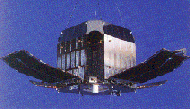|
|
Tenma [Astro B]

Tenma is the eighth Japanese scientific satellite from the Institute of Space and
Astronautical Science (ISAS) and the second X-ray astronomy satellite after
Hakucho.
It was placed into a near circular orbit with a apogee of 501 km,
a perigee of 497 km and an inclination angle of 31.5 degrees.
Tenma was a spin-stabilized satellite and the FOV of the scientific
payload was mostly aligned with the spin-axis (Z-axis).
The main objective of Tenma was to perform spectral and temporal
observations of galactic and extra-galactic sources with particular emphasis
on energy spectra thanks to the improved energy resolution of the on-board
instrumentation.
The observing efficency was reduced greatly (only daytime operations)
after the battery failed in July 1984. Observations continued intermittently
until 11 November 1985, when operations were stopped because they were too
inefficient. It re-entered on January 19 1989.
Tenma carried four high-energy experiments. They were:
- Gas Scintillation Proportional Counter. This was the primary instrument on
the satellite. Its main objective was the spectral and temporal study
of cosmic X-ray sources in the range 2-60 keV. It consisted of 10 gas
scintillation proportional counters (GSPC), with an effective
area of 80 sq-cm each. The ten counters were divided into three groups
SPC-A, B and C. The A and B consisted of 4 counters with
honeycomb collimators with a FOV of 3.1 and 2.5° (FWHM), the C
instead consisted in 2 counters with a 3.8° FOV (FWHM).
The energy resolution was about 9.5% at 6 keV,
about half of the conventional proportional counters used so far.
- X-ray Focusing Collector. This instrument's main objective was the
study of soft X-ray sources in the range 0.1-2 keV. The system
consisted of 2 identical co-aligned subsystems, each with a position
sensitive proportional counter. The peak effective area was ~ 7 sq-cm
for each subsystem at 0.7 keV. The field of view was 5 degrees x 0.2
degrees (FWHM), divided into 7 resolution elements.
- Transient Source Monitor. This instrument carried out continuous
monitoring of a wide field of the sky (45 degree radius). It consisted
of 2 detector groups: (1) a Hadamard X-ray telescope and (2) a
scanning counter. The experiment was sensitive to the energy range
2-10 keV.
- Radiation Belt Monitor/Gamma-Ray Burst Detector. This experiment
consisted of 2 sets of scintillation counters with an effective area
of 7 sq-cm each. Their primary purpose was to monitor the background
variations. They were also used as alarms for satellite entry into the
radiation belts. The system could also record gamma-ray bursts with
1/8 s resolution, with a detection limit of ~10-5
erg/sq-cm for the burst size.
The main science result is the discovery (and/or study) of the iron line region
in several classes of X-ray sources.
In particular, it discovered such emission from low-mass X
-ray binaries (LMXB) and from the galactic ridge. The spectral resolution
allowed a distinction to be made from "cold" iron line emission at 6.4 keV
believed to arise from X-rays impinging on cold matter and "hot" 6.6-6.7 keV
iron emission believed to arise from a hot plasma. The "cold" line was found in
pulsars and AGN; the "hot" line was found in LMXB and the galactic ridge.
[Tenma Home]
[About Tenma]
[Gallery]
[Publications]
Page authors: Lorella Angelini Jesse Allen
HEASARC Home |
Observatories |
Archive |
Calibration |
Software |
Tools |
Students/Teachers/Public
Last modified: Tuesday, 07-Oct-2003 11:15:49 EDT
|


